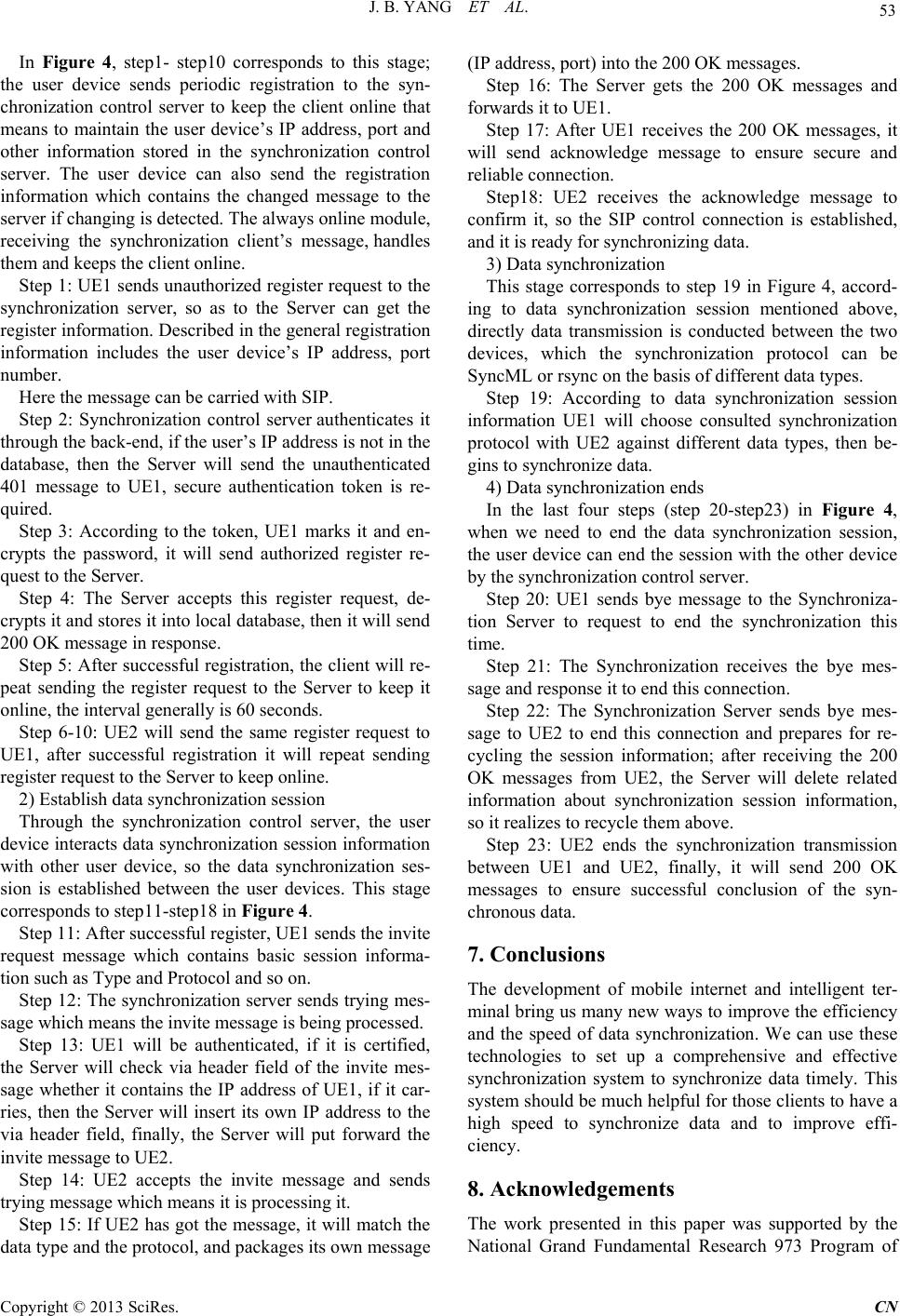
J. B. YANG ET AL. 53
In Figure 4, step1- step10 corresponds to this stage;
the user device sends periodic registration to the syn-
chronization control server to keep the client online that
means to maintain the user device’s IP address, port and
other information stored in the synchronization control
server. The user device can also send the registration
information which contains the changed message to the
server if changing is detected. The always online module,
receiving the synchronization client’s message, handles
them and keeps the client online.
Step 1: UE1 sends unauthorized register request to the
synchronization server, so as to the Server can get the
register information. Described in the general registration
information includes the user device’s IP address, port
number.
Here the message can be carried with SIP.
Step 2: Synchronization control server authenticates it
through the back-end, if the user’s IP address is not in the
database, then the Server will send the unauthenticated
401 message to UE1, secure authentication token is re-
quired.
Step 3: According to the token, UE1 marks it and en-
crypts the password, it will send authorized register re-
quest to the Server.
Step 4: The Server accepts this register request, de-
crypts it and stores it into local datab ase, then it will send
200 OK message in response.
Step 5: After successful registration, the client will re-
peat sending the register request to the Server to keep it
online, the in terval generally is 60 seconds.
Step 6-10: UE2 will send the same register request to
UE1, after successful registration it will repeat sending
register request to the Server to keep on line.
2) Establish data synchronization session
Through the synchronization control server, the user
device interacts data synchronization session information
with other user device, so the data synchronization ses-
sion is established between the user devices. This stage
corresponds to step11-step18 in Figure 4.
Step 11: After successful register, UE1 sends the invite
request message which contains basic session informa-
tion such as Type and Protocol and so on.
Step 12: The synchr onization server sends trying mes-
sage which means the invite message is being processed.
Step 13: UE1 will be authenticated, if it is certified,
the Server will check via header field of the invite mes-
sage whether it contains the IP address of UE1, if it car-
ries, then the Server will insert its own IP address to the
via header field, finally, the Server will put forward the
invite message to UE2.
Step 14: UE2 accepts the invite message and sends
trying message which means it is processing it.
Step 15: If UE2 has got the message, it will match the
data type and the protocol, and packages its own message
(IP address, port) into th e 200 OK messages.
Step 16: The Server gets the 200 OK messages and
forwards it to UE1.
Step 17: After UE1 receives the 200 OK messages, it
will send acknowledge message to ensure secure and
reliable connection.
Step18: UE2 receives the acknowledge message to
confirm it, so the SIP control connection is established,
and it is ready for synchron izing data.
3) Data synchronization
This stage corresponds to step 19 in Figure 4, accord-
ing to data synchronization session mentioned above,
directly data transmission is conducted between the two
devices, which the synchronization protocol can be
SyncML or rsync on the basis of different da ta types.
Step 19: According to data synchronization session
information UE1 will choose consulted synchronization
protocol with UE2 against different data types, then be-
gins to synchronize data.
4) Data synchronization ends
In the last four steps (step 20-step23) in Figure 4,
when we need to end the data synchronization session,
the user device can end the session with the other device
by the synchro nizat i on co nt r o l serve r.
Step 20: UE1 sends bye message to the Synchroniza-
tion Server to request to end the synchronization this
time.
Step 21: The Synchronization receives the bye mes-
sage and response it to end this connection.
Step 22: The Synchronization Server sends bye mes-
sage to UE2 to end this connection and prepares for re-
cycling the session information; after receiving the 200
OK messages from UE2, the Server will delete related
information about synchronization session information,
so it realizes to recycle them above.
Step 23: UE2 ends the synchronization transmission
between UE1 and UE2, finally, it will send 200 OK
messages to ensure successful conclusion of the syn-
chronous da t a .
7. Conclusions
The development of mobile internet and intelligent ter-
minal bring us many new ways to improve the efficiency
and the speed of data synchronization. We can use these
technologies to set up a comprehensive and effective
synchronization system to synchronize data timely. This
system should be much helpful for those clients to have a
high speed to synchronize data and to improve effi-
ciency.
8. Acknowledgements
The work presented in this paper was supported by the
National Grand Fundamental Research 973 Program of
Copyright © 2013 SciRes. CN